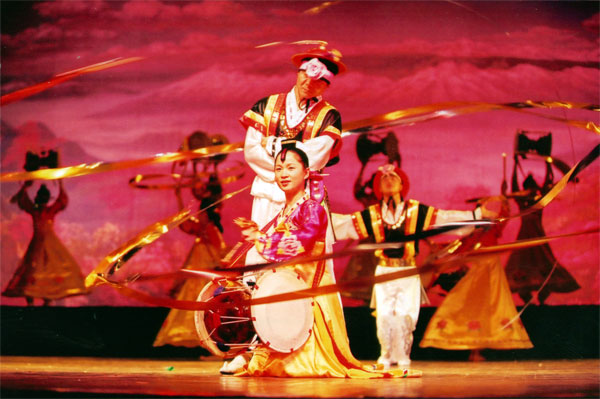 |
|
Dancers perform the elephant cape dance. [Photo/jl.gov.cn]
|
Wangqing County, located in Jilin's Yanbian Korean Autonomous Prefecture, is known as the hometown of the Chinese elephant cap dance. Fifty-six-year-old Jin Mingchun is leading efforts to preserve the traditional folk art. As director of Wangqing's Center for Preservation of Intangible Cultural Heritage, Jin has devoted 35 years to continuing the ethnic Korean farmers' dance. He is also the only dancer who can perform the elephant cap dance with a 32-meter-long tail, and has won many awards including the "Lotus Award" representing the highest national honor for dancers. In 2009, UNESCO recognized the ethnic Korean farmers' dance as an Intangible Cultural Heritage of Humanity and Jin Ming-chun was recognized as its inheritor.
THE elephant cap dance is one of the most unique and representative folk dances among Chinese ethnic Koreans, characterized by long history and rich content. The dance is performed with long streamers secured to the top of the dancers' cap. Male dancers use their necks to swing the colorful 20-meter streamers, accompanied by music and singing. Often performed on festivals or celebration days, elephant cap dancers can turn the streamers into beautiful rings around the dancers and dazzle the spectators. The fast-paced rhythm and lively movements reflect the joy and enthusiasm of ethnic Koreans at work and at home.
Born for the Dance
Jin Mingchun was born in a farming village in Wangqing County. As a boy he enjoyed cultural and artistic activities and became proficient at the bamboo flute, comic drama and crosstalk. He was always full of energy and enthusiasm, practicing his performances whenever he had a spare moment from farmwork.
In 1978, Jin got his start when the local cultural station launched an elephant cap dance class. Jin made an ersatz elephant cap from an aluminum washbowl, abacus beads, bicycle spokes and paper. "It only took three days for me to master the basics of the elephant cap dance, so I felt that I might be talented at it. I had many ideas for choreographing new dances. I felt born for the dance," Jin said.
In order to improve, Jin continued to try more difficult movements and longer practice. Once, after over zealous practicing, he couldn't move his neck for a week. In the daytime, he worked in the commune; his evenings were dedicated to rehearsals for the publicity team. With no money to purchase costumes and props, Jin made them himself with any materials available. "I persisted practicing for eight years and never felt that life was hard or tiring," Jin said. In 1986, when Jin participated in a joint cultural performance of the Three Northeastern Provinces of China, he passed several rounds of competition and won the Special Award.
Over the past decades, Jin has never slackened his efforts in practicing. He has continuously improved his performance skills and added new movements and content to the folk dance. During daily practice or in his teaching class, Jin is always thinking about new movements. Sometimes he stays up at nights, filling notebooks with new ideas. When directing dance programs, he often tries to incorporate elements of martial arts, street-dancing and ballet, creating a novel and distinctive style. He has also improved many traditional acrobatic movements in the elephant cap dance to attract more viewers. After long study and practice, Jin made new elephant caps out of aluminum alloy with three colorful tapes of different lengths. The three tapes can be twirled at the same time, forming a wonderful image. Today, Jin is the only man in China who can swing a cap with 32-meter-long ribbons.
Recommend:
